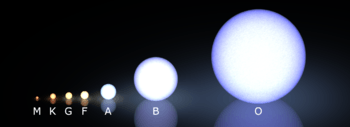HD 133600
| Observation data Epoch J2000.0 Equinox J2000.0 (ICRS) | |
|---|---|
| Constellation | Virgo |
| Right ascension | 15h 05m 13.2488s[1] |
| Declination | +06° 17′ 23.676″[1] |
| Apparent magnitude (V) | 8.219[1] |
| Characteristics | |
| Spectral type | G0[1] |
| B−V color index | 0.6[1] |
| V−R color index | 0.4[1] |
| R−I color index | 0.2[1] |
| Astrometry | |
| Proper motion (μ) | RA: −2.40[1] mas/yr Dec.: −248.01[1] mas/yr |
| Parallax (π) | 19.12 ± 1.11[1] mas |
| Distance | 171 ± 10 ly (52 ± 3 pc) |
| Absolute magnitude (MV) | 4.6[2] |
| Details | |
| Mass | 1.00 ± 0.03 [3] M☉ |
| Luminosity | 8.219 [3] L☉ |
| Temperature | 5810 ± 36 [3] K |
| Metallicity | [Fe/H] 0.010 [3] |
| Age | 6.3 ± 1.0 [3] Gyr |
| Other designations | |
| Database references | |
| SIMBAD | data |
HD 133600 [4], also known as HIP 73815, is a G-type star in the constellation of Virgo.[1] It has an apparent visual magnitude of approximately 8.219m.[1] It is similar to the Sun and has been called a near solar twin, as it is 1.5 billion years older than the Sun.[5]
Its distance is 52.3 parsecs (171 light years) from the Sun. Mass is within 3 percent of the Sun.[6]
Near solar twins can help us to understand solar activity such as solar flares and sunspot cycles over longer time periods than the historical records, and to put unique historical events such as the Maunder minimum in context. They can also be used to set the zero point of fundamental calibrations in astrophysics, and models of solar evolution.[6]
Near solar twins can also help answer whether the Sun is unique or not. It used to be thought that the Sun might be unique for its low lithium abundance. This star was one of two stars that were used in 2007 papers by Melendez & Ramırez[6] to show that the Sun was not unique in this respect as it has lithium abundance similar to our Sun, but is not an idea comparison as HD 133600 is 1.5 billion years older than the Sun. Yet, this has made it a useful star for studies into the problem of the depleted lithium abundance at the solar surface compared with other stars, something that is not yet fully understood, and known as the Lithium depletion problem.
Sun comparison
This chart compares the Sun to HD 133600.
| Identifier | J2000 Coordinates | Distance (ly) |
Stellar Class |
Temperature (K) |
Metallicity (dex) |
Age (Gyr) |
Notes | |
|---|---|---|---|---|---|---|---|---|
| Right ascension | Declination | |||||||
| Sun | — | — | 0.00 | G2V | 5,778 | +0.00 | 4.6 | [7] |
| HD 133600 [8] | 15h 05m 13.2s | +06° 17′ 24″ | 171 | G0 | 5,808 | +0.02 | 6.3 | [9][3] |
To date no solar twin with an exact match as that of the Sun has been found, however, there are some stars that come very close to being identical to that of the Sun, and are such considered solar twins by the majority of the public. An exact solar twin would be a G2V star with a 5,778K temperature, be 4.6 billion years old, with the correct metallicity and a 0.1% solar luminosity variation.[10] Stars with an age of 4.6 billion years are at the most stable state. Proper metallicity and size are also very important to low luminosity variation. [11][12][13]

References
- 1 2 3 4 5 6 7 8 9 10 11 12 13 LTT 14484 -- High proper-motion Star, database entry, SIMBAD. Accessed on line February 3, 2011.
- ↑ From apparent magnitude and parallax.
- 1 2 3 4 5 6 "Age and mass of solar twins constrained by lithium abundance, January 3, 2014" (PDF). arxiv. Cornell University - Astronomy & Astrophysics manuscript. Retrieved July 13, 2016.
- ↑ HD 133600 at SIMBAD.
- Ids - Bibliography - Siblings - Star plot - Image.
- ↑ Accurate abundance patterns of solar twins and analogs. Does the anomalous solar chemical composition come from planet formation?, I. Ramírez, J. Meléndez, and M. Asplund, Astronomy and Astrophysics 508, #1 (December 2009), doi:10.1051/0004-6361/200913038, Bibcode: 2009A&A...508L..17R.
- 1 2 3 HIP 56948: A SOLAR TWIN WITH A LOW LITHIUM ABUNDANCE , Jorge Melendez and Ivan Ramırezd, The Astrophysical Journal, 669: L89–L92, 2007 November 10. (also discusses HIP 73815, compares it with HIP 56948)
- ↑ Williams, D.R. (2004). "Sun Fact Sheet". NASA. Retrieved 2009-06-23.
- ↑ HD 133600 at SIMBAD - Ids - Bibliography - Image.
- ↑ Meléndez, Jorge; Ramírez, Iván (November 2007). "HIP 56948: A Solar Twin with a Low Lithium Abundance". The Astrophysical Journal. 669 (2): L89–L92. arXiv:0709.4290
 . Bibcode:2007ApJ...669L..89M. doi:10.1086/523942.
. Bibcode:2007ApJ...669L..89M. doi:10.1086/523942. - ↑ NASA, Science News, Solar Variability and Terrestrial Climate, Jan. 8, 2013
- ↑ University of Nebraska-Lincoln astronomy education group, Stellar Luminosity Calculator
- ↑ National Center for Atmospheric Research, The Effects of Solar Variability on Earth's Climate, 2012 Report
- ↑ Most of Earth’s twins aren’t identical, or even close!, by Ethan on June 5, 2013